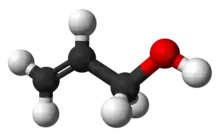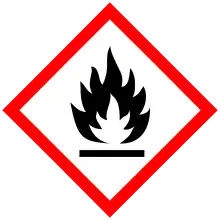 | |
 | |
| Names | |
|---|---|
| Preferred IUPAC name
Prop-2-en-1-ol | |
| Other names | |
| Identifiers | |
3D model (JSmol) |
|
| 3DMet | |
| ChEBI | |
| ChEMBL | |
| ChemSpider | |
| ECHA InfoCard | 100.003.156 |
| EC Number |
|
| KEGG | |
PubChem CID |
|
| RTECS number |
|
| UNII | |
| UN number | 1098 |
CompTox Dashboard (EPA) |
|
| |
| |
| Properties | |
| C3H6O | |
| Molar mass | 58.080 g·mol−1 |
| Appearance | colorless liquid[1] |
| Odor | mustard-like[1] |
| Density | 0.854 g/ml |
| Melting point | −129 °C |
| Boiling point | 97 °C (207 °F; 370 K) |
| Miscible | |
| Vapor pressure | 17 mmHg[1] |
| Acidity (pKa) | 15.5 (H2O)[2] |
| -36.70·10−6 cm3/mol | |
| Hazards | |
| Occupational safety and health (OHS/OSH): | |
Main hazards |
Highly toxic, lachrymator |
| GHS labelling: | |
    | |
| Danger | |
| H225, H301, H302, H311, H315, H319, H331, H335, H400 | |
| P210, P233, P240, P241, P242, P243, P261, P264, P270, P271, P273, P280, P301+P310, P302+P352, P303+P361+P353, P304+P340, P305+P351+P338, P311, P312, P321, P322, P330, P332+P313, P337+P313, P361, P362, P363, P370+P378, P391, P403+P233, P403+P235, P405, P501 | |
| NFPA 704 (fire diamond) | |
| Flash point | 21 °C (70 °F; 294 K) |
| 378 °C (712 °F; 651 K) | |
| Explosive limits | 2.5–18.0% |
| Lethal dose or concentration (LD, LC): | |
LD50 (median dose) |
80 mg/kg (rat, orally)[3] |
LC50 (median concentration) |
1000 ppm (mammal, 1 hr) 76 ppm (rat, 8 hr) 207 ppm (mouse, 2 hr) 1000 ppm (rabbit, 3.5 hr) 1000 ppm (monkey, 4 hr) 1060 ppm (rat, 1 hr) 165 ppm (rat, 4 hr) 76 ppm (rat, 8 hr)[4] |
| NIOSH (US health exposure limits): | |
PEL (Permissible) |
2 ppm[1] |
REL (Recommended) |
TWA 2 ppm (5 mg/m3) ST 4 ppm (10 mg/m3) [skin] [1] |
IDLH (Immediate danger) |
20 ppm[1] |
| Safety data sheet (SDS) | External MSDS |
Except where otherwise noted, data are given for materials in their standard state (at 25 °C [77 °F], 100 kPa).
Infobox references | |
Allyl alcohol (IUPAC name: prop-2-en-1-ol) is an organic compound with the structural formula CH2=CHCH2OH. Like many alcohols, it is a water-soluble, colourless liquid. It is more toxic than typical small alcohols. Allyl alcohol is used as a precursor to many specialized compounds such as flame-resistant materials, drying oils, and plasticizers.[5] Allyl alcohol is the smallest representative of the allylic alcohols.
Production
Allyl alcohol is produced commercially by the Olin and Shell corporations through the hydrolysis of allyl chloride:
Allyl alcohol can also be made by the rearrangement of propylene oxide, a reaction that is catalyzed by potassium alum at high temperature. The advantage of this method relative to the allyl chloride route is that it does not generate salt. Also avoiding chloride-containing intermediates is the "acetoxylation" of propylene to allyl acetate:
Hydrolysis of this acetate gives allyl alcohol. In alternative fashion, propylene can be oxidized to acrolein, which upon hydrogenation gives the alcohol.
In principle, allyl alcohol can be obtained by dehydrogenation of propanol.
Laboratory methods
In the laboratory, glycerol reacts with oxalic or formic acids to give (respectively) dioxalin or glyceric formate, either of which decarboxylate and dehydrate to allylol.[6][7]
Allyl alcohols in general are prepared by allylic oxidation of allyl compounds, using selenium dioxide or organic peroxides. Other methods include carbon-carbon bond-forming reactions such as the Prins reaction, the Morita-Baylis-Hillman reaction, or a variant of the Ramberg-Bäcklund reaction. Hydrogenation of enones is another route. Some of these methods are achieved by the Luche reduction, Wharton reaction, and the Mislow-Evans rearrangement.
Allyl alcohol was first prepared in 1856 by Auguste Cahours and August Hofmann by hydrolysis of allyl iodide.[5] Today a Allyl alcohol can be formed after trituration of garlic (Allium sativum) cloves.[8]
Applications
Allyl alcohol is converted mainly to glycidol, which is a chemical intermediate in the synthesis of glycerol, glycidyl ethers, esters, and amines. Also, a variety of polymerizable esters are prepared from allyl alcohol, e.g. diallyl phthalate.[5]
Allyl alcohol has an antifungal effect by inhibiting the growth of Candida albicans.[8]
Safety
Allyl alcohol is more toxic, especially hepatotoxic than related alcohols.[5][9] Its threshold limit value (TLV) is 2 ppm. It is a lachrymator.[5]
See also
References
- 1 2 3 4 5 6 7 8 NIOSH Pocket Guide to Chemical Hazards. "#0017". National Institute for Occupational Safety and Health (NIOSH).
- ↑ Haynes, William M., ed. (2016). CRC Handbook of Chemistry and Physics (97th ed.). CRC Press. p. 5–88. ISBN 978-1498754286.
- ↑ Allyl alcohol toxicity
- ↑ "Allyl alcohol". Immediately Dangerous to Life or Health Concentrations (IDLH). National Institute for Occupational Safety and Health (NIOSH).
- 1 2 3 4 5 Ludger Krähling; Jürgen Krey; Gerald Jakobson; Johann Grolig; Leopold Miksche (2002). "Allyl Compounds". Ullmann's Encyclopedia of Industrial Chemistry. Weinheim: Wiley-VCH. doi:10.1002/14356007.a01_425. ISBN 978-3527306732.
- ↑ Oliver Kamm & C. S. Marvel (1941). "Allyl alcohol". Organic Syntheses. 1: 15. doi:10.15227/orgsyn.001.0015.
- ↑ Cohen, Julius (1900). Practical Organic Chemistry (2nd ed.). London: Macmillan and Co., Limited. p. 96.
Practical Organic Chemistry Cohen Julius.
- 1 2 Lemar, Katey M.; Passa, Ourania; Aon, Miguel A.; Cortassa, Sonia; Müller, Carsten T.; Plummer, Sue; O'Rourke, Brian; Lloyd, David (2005). "Allyl alcohol and garlic (Allium sativum) extract produce oxidative stress in Candida albicans". Microbiology. 151 (10): 3257–3265. doi:10.1099/mic.0.28095-0. ISSN 1465-2080. PMC 2711876. PMID 16207909.
- ↑ "National Technical Information Service". US Environmental Protection Agency. 1984.
External links
- International Chemical Safety Card 0095
- NIOSH Pocket Guide to Chemical Hazards. "#0017". National Institute for Occupational Safety and Health (NIOSH).
- Institut national de recherche et de sécurité (2004). "Alcool allylique." Fiche toxicologique n° 156. Paris:INRS. (in French)
- State of Michigan public information on allyl alcohol
- Occupational exposure guidelines
